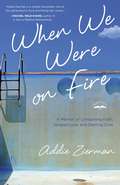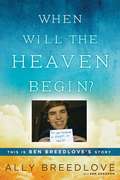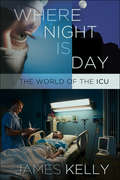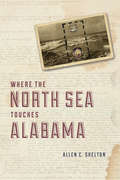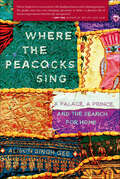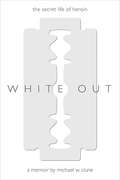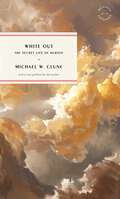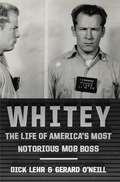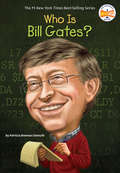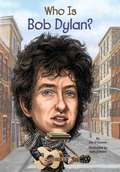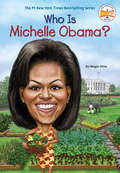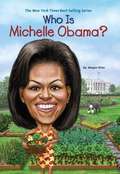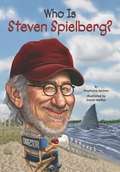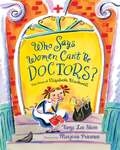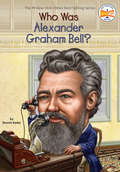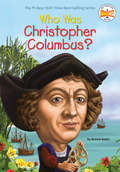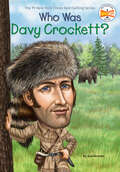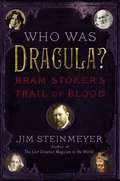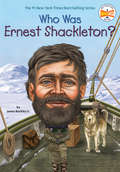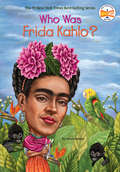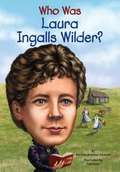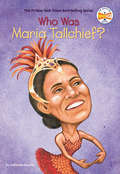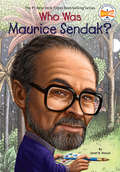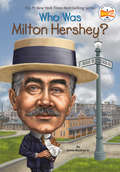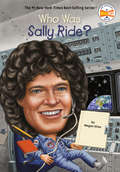- Table View
- List View
When We Were on Fire: A Memoir of Consuming Faith, Tangled Love, and Starting Over
by Addie ZiermanIn the strange, us-versus-them Christian subculture of the 1990s, a person's faith was measured by how many WWJD bracelets she wore and whether he had kissed dating goodbye. Evangelical poster child Addie Zierman wore three bracelets asking what Jesus would do. She also led two Bible studies and listened exclusively to Christian music. She was on fire for God and unaware that the flame was dwindling--until it burned out. Addie chronicles her journey through church culture and first love, and her entrance--unprepared and angry--into marriage. When she drops out of church and very nearly her marriage as well, it is on a sea of tequila and depression. She isn't sure if she'll ever go back. When We Were on Fire is a funny, heartbreaking story of untangling oneself from what is expected to arrive at faith that is not bound by tradition or current church fashion. Addie looks for what lasts when nothing else seems worth keeping. It's a story for doubters, cynics, and anyone who has felt alone in church. returning to love, Jesus, and (perhaps toughest of all) his imperfect followers. And, in the end, it's about what lasts when nothing else seems worth keeping.
When Will the Heaven Begin?
by Ally Breedlove Ken AbrahamAN INSPIRATIONAL AND HEARTRENDING MEMOIR ABOUT BEN BREEDLOVE, WHO SHARED HIS NEAR-DEATHEXPERIENCES AND VISIONS OF HEAVEN IN HIS VIRAL VIDEOS--WRITTEN BY HIS SISTER, ALLY BREEDLOVE.<P>P>On Christmas Day 2011, Ben Breedlove's soul went to heaven. But it wasn't his first time there. Ben suffered from hypertrophic cardiomyopathy (HCM), a heart condition that posed a constant risk of sudden death. His condition, a thickening of the heart muscle, worsened over time, leaving him weak and fatigued. It also led Ben to some close calls medically, in particular cardiac arrest on four separate occasions, during which he felt the presence of angels and experienced the perfect peace of heaven.<P>Precocious and warm, Ben was close with his family and two siblings, and forged deep relationships with his friends. He loved to wakeboard and wake surf, and he had dreams of visiting foreign countries around the world. He created the YouTube channels TotalRandomness512 and BreedloveTV, and co-created the channel OurAdvice4You, where he posted videos about everything from dating advice for girls to more serious topics like his spirituality and heart condition.Unbeknownst to his parents and family, Ben created a two-part video called "This Is My Story," in which he used flashcards to tell the world about his near-death experiences and his beckoning toward heaven.When he died a short while later, at the tender age of eighteen, his family and the rest of the world stumbled upon these videos. <P>The world responded with overwhelming acceptance of the message Ben shared.Sharing his vision of heaven was Ben's gift to his family, and to the world. And now this is the Breedlove family's gift to us - an in-depth look at the life and near-deaths of Ben, the strength and faith of a family, and ultimately, the hope of heaven.Do you believe in Angels or God? I Do. - Ben Breedlove
Where Night Is Day: The World of the ICU (The Culture and Politics of Health Care Work)
by James Kelly"There is no night in the ICU. There is day, lesser day, then day again. There are rhythms. Every twelve hours: shift change. Report: first all together in the big room, then at the bedside, nurse to nurse. Morning rounds. A group of doctors moves slowly through the unit like a harrow through a field. At each room, like a game, a different one rotates into the center. They leave behind a trail of new orders. Wean, extubate, titrate, start this, stop that, scan, film, scope. The steep hill the patient is asked to climb. Can you breathe on your own? Can you wake up? Can you live?"-from Where Night Is DayWhere Night Is Day is a nonfiction narrative grounded in the day-by-day, hour-by-hour rhythms of an ICU in a teaching hospital in the heart of New Mexico. It takes place over a thirteen-week period, the time of the average rotation of residents through the ICU. It begins in September and ends at Christmas. It is the story of patients and families, suddenly faced with critical illness, who find themselves in the ICU. It describes how they navigate through it and find their way. James Kelly is a sensitive witness to the quiet courage and resourcefulness of ordinary people. Kelly leads the reader into a parallel world: the world of illness. This world, invisible but not hidden, not articulated by but known by the ill, does not readily offer itself to our understanding. In this context, Kelly reflects on the nature of medicine and nursing, on how doctors and nurses see themselves and how they see each other. Drawing on the words of medical historians, doctor-writers, and nursing scholars, as well as the works of James Agee and Michel de Certeau, Kelly examines the relationship of professional and lay observers to the meaning of illness, empathy, caring, and the silence of suffering. As Kelly reflects on the rise of medicine, the theory of nursing, the argument of care versus cure, he offers up an intimate portrait of the ICU and its inhabitants.
Where the North Sea Touches Alabama
by Allen C. SheltonOn a warm summer's night in Athens, Georgia, Patrik Keim stuck a pistol into his mouth and pulled the trigger. Keim was an artist, and the room in which he died was an assemblage of the tools of his particular trade: the floor and table were covered with images, while a pair of large scissors, glue, electrical tape, and some dentures shared space with a pile of old medical journals, butcher knives, and various other small objects. Keim had cleared a space on the floor, and the wall directly behind him was bare. His body completed the tableau. Art and artists often end in tragedy and obscurity, but Keim's story doesn't end with his death. A few years later, 180 miles away from Keim's grave, a bulldozer operator uncovered a pine coffin in an old beaver swamp down the road from Allen C. Shelton's farm. He quickly reburied it, but Shelton, a friend of Keim's who had a suitcase of his unfinished projects, became convinced that his friend wasn't dead and fixed in the ground, but moving between this world and the next in a traveling coffin in search of his incomplete work. In Where the North Sea Touches Alabama, Shelton ushers us into realms of fantasy, revelation, and reflection, paced with a slow unfurling of magical correspondences. Though he is trained as a sociologist, this is a genre-crossing work of literature, a two-sided ethnography: one from the world of the living and the other from the world of the dead. What follows isn't a ghost story but an exciting and extraordinary kind of narrative. The psycho-sociological landscape that Shelton constructs for his reader is as evocative of Kafka, Bataille, and Benjamin as it is of Weber, Foucault, and Marx. Where the North Sea Touches Alabama is a work of sociological fictocriticism that explores not only the author's relationship to the artist but his physical, historical, and social relationship to northeastern Alabama, in rare style.
Where the Peacocks Sing: A Palace, a Prince, and the Search for Home
by Alison Singh GeeHow far would you travel for love? In her sparkling memoir, journalist Alison Singh Gee learns that love, riches, and a place to call home can be found in the most unexpected places. Alison Singh Gee was a glamorous magazine writer with a serious Jimmy Choo habit, a weakness for five-star Balinese resorts, and a reputation for dating highborn British men. Then she met Ajay, a charming and unassuming Indian journalist, and her world turned upside down. Traveling from her shiny, rapid-fire life in Hong Kong to Ajay's native village, Alison learns that not all is as it seems. Turns out that Ajay is a landed prince (of sorts), but his family palace is falling to pieces. Replete with plumbing issues, strange noises, and intimidating relatives, her new love's ramshackle palace, Mokimpur, is a broken-down relic in desperate need of a makeover. And Alison wonders if she can soldier on for the sake of the man who just might be her soul mate. This modern-day fairytale, WHERE THE PEACOCKS SING, takes readers on a cross-cultural journey from the manicured gardens of Beverly Hills, to the bustling streets of Hong Kong and finally to the rural Indian countryside as Alison comes to terms with her complicated new family, leaves the modern world behind, and learns the true meaning of home.
White Out: The Secret Life of Heroin
by Michael Wesley CluneClune’s gripping account of life inside the heroin underground reads like no other, as we enter the mind of the addict and navigate the world therein.How do you describe an addiction in which the drug of choice creates a hole in your memory, a “white out,” so that every time you use it is the first time--new, fascinating, and vivid? Michael W. Clune’s original, edgy yet literary telling of his own story takes us straight inside such an addiction--what he calls the Memory Disease.With black humor and quick, rhythmic prose, Clune’s gripping account of life inside the heroin underground reads like no other, as we enter the mind of the addict and navigate the world therein. Clune whisks us between the streets of Baltimore and the university campus, revealing his dual life while a graduate student teaching literature. We spiral downward with Clune--from nodding off in an abandoned row-house with a one-armed junkie and a murderous Jesus freak to scanning a crowded lecture hall for an enemy with a gun.After experiencing his descent into addiction, we go with him through detox, treatment, and finally into recovery as he returns to his childhood home and to the world of color. It is there that the Memory Disease and his heroin-induced white out begins to fade.
White Out
by Michael W. CluneA classic of addiction and recovery.How do you describe an addiction in which your drug of choice creates a hole in your memory, a &“white out,&” so that every time you use it is the first time—new, fascinating, vivid? Michael W. Clune&’s story takes us straight inside such an addiction—what he calls &“the memory disease.&” With dark humor, and in crystalline prose, Clune&’s account of life inside the heroin underground reads like no other. Whisking us between the halves of his precarious double life—between the streets of Baltimore and the college classroom, where Clune is a graduate student teaching literature—we spiral along with him as he approaches rock bottom: from nodding off in a row house with a one-armed junkie and a murderous religious freak to having his life threatened in a Chicago jail while facing a felony possession charge. After his descent into addiction, we follow Clune through detox, treatment, and finally into recovery as he returns to his childhood home, where the memory disease and his heroin-induced white out begin to fade. White Out is more than a memoir. It is a rigorous investigation that offers clarity, hope, and even beauty to anyone who wants to understand the disease or its cure. This tenth anniversary edition includes a new preface by the author.
Whitey: The Life of America's Most Notorious Mob Boss
by Dick Lehr Gerard O'NeillFrom the bestselling authors of Black Mass comes the definitive biography of Whitey Bulger, the most brutal and sadistic crime boss since Al Capone. Drawing on a trove of sealed files and previously classified material, Whitey digs deep into the mind of James J. "Whitey" Bulger, the crime boss and killer who brought the FBI to its knees. He is an American original --a psychopath who fostered a following with a frightening mix of terror, deadly intimidation and the deft touch of a politician who often helped a family in need meet their monthly rent. But the history shows that despite the early false myths portraying him as a Robin Hood figure, Whitey was a supreme narcissist, and everything--every interaction with family and his politician brother Bill Bulger, with underworld cohorts, with law enforcement, with his South Boston neighbors, and with his victims--was always about him. In an Irish-American neighborhood where loyalty has always been rule one, the Bulger brand was loyalty to oneself. Whitey deconstructs Bulger's insatiable hunger for power and control. Building on their years of reporting and uncovering new Bulger family records, letters and prison files, Dick Lehr and Gerard O'Neill examine and reveal the factors and forces that created the monster. It's a deeply rendered portrait of evil that spans nearly a century, taking Whitey from the streets of his boyhood Southie in the 1940s to his cell in Alcatraz in the 1950s to his cunning, corrupt pact with the FBI in the 1970s and, finally, to Santa Monica, California where for fifteen years he was hiding in plain sight as one of the FBI's Ten Most Wanted. In a lifetime of crime and murder that ended with his arrest in June 2011, Whitey Bulger became one of the most powerful and deadly crime bosses of the twentieth century. This is his story.
Who Is Bill Gates? (Who was?)
by Nancy Harrison Patricia Brennan Demuth Ted HammondBill Gates, born in Seattle, Washington, in 1955, is an American business magnate, investor, philanthropist, and author. In this Who Was...? biography, children will learn of Gates' childhood passion for computer technology, which led him to revolutionize personal computers. Through the success of his now-world-famous software company, Microsoft, Bill Gates became one of the wealthiest philanthropists in history.This fascinating story of a child technology genius is sure to captivate all audiences!
Who Is Bob Dylan? (Who was?)
by John O'Brien Nancy Harrison Jim O'ConnorA singer-songwriter, musician, and artist, Bob Dylan is an American icon. In the past five decades, Dylan's work has influenced everyone from John Lennon, Bruce Springsteen, and David Bowie to rapper Eminem. Young music lovers will be fascinated by this great artist's life!
Who Is Michelle Obama? (Who Was?)
by John O'Brien Nancy Harrison Megan StineBorn into a close knit family in Chicago, Michelle Robinson was a star student who graduated from Princeton and Harvard Law. Then in 1992, she married another promising young lawyer and the rest, as they say, is history. It is undeniable that President Barack Obama has changed the United States but so has Michelle Obama, the self proclaimed "Mom in Chief." This compelling, easy-to-read biography is illustrated by New Yorker artist John O'Brien.
Who Is Michelle Obama? (Who was?)
by Megan Stine John O'Brien Nancy HarrisonBorn into a close knit family in Chicago, Michelle Robinson was a star student who graduated from Princeton and Harvard Law. Then in 1992, she married another promising young lawyer and the rest, as they say, is history. It is undeniable that President Barack Obama has changed the United States but so has Michelle Obama, the self proclaimed "Mom in Chief. " This compelling, easy-to-read biography is illustrated by New Yorker artist John O'Brien.
Who Is Steven Spielberg?
by Daniel Mather Stephanie SpinnerWhile other kids played sports, Steven Spielberg was writing scripts and figuring out camera angles. He went from entertaining his Boy Scout troop with home movies to amazing audiences around the world with epic blockbusters. He has directed four of the most successful films of all time and has won two Academy Awards for Best Director. From Jaws to Lincoln, young readers and aspiring filmmakers will be fascinated by the life of this famous director.
Who Says Women Can't Be Doctors?: The Story Of Elizabeth Blackwell
by Tanya Lee Stone Marjorie Priceman<P>In the 1830s, when a brave and curious girl named Elizabeth Blackwell was growing up, women were supposed to be wives and mothers. <P>Some women could be teachers or seamstresses, but career options were few. <P>Certainly no women were doctors. But Elizabeth refused to accept the common beliefs that women weren't smart enough to be doctors, or that they were too weak for such hard work. And she would not take no for an answer. <P>Although she faced much opposition, she worked hard and finally-when she graduated from medical school and went on to have a brilliant career-proved her detractors wrong. <P>This inspiring story of the first female doctor shows how one strong-willed woman opened the doors for all the female doctors to come.
Who Was Alexander Graham Bell?
by David Groff Bonnie BaderDid you know that Bell's amazing invention--the telephone--stemmed from his work on teaching the deaf? Both his mother and wife were deaf. Or, did you know that in later years he refused to have a telephone in his study? Bell's story will fascinate young readers interested in the early history of modern technology!
Who Was Christopher Columbus? (Who was?)
by Nancy Harrison Bonnie BaderLearn all about Christopher Columbus' early life at sea, which led him to seek fortune by sailing west in hopes of creating new trade routes with the Indies. Kids will read about why he called himself the "Great Admirald of the Seas" and learn of all his struggles to find finacial support for his voyage.
Who Was Davy Crockett? (Who was?)
by Nancy Harrison Gail Herman Robert SquierDavy Crockett, the King of the Wild Frontier, is a man of legend. He is said to have killed his first bear when he was three years old. His smile alone killed another, and he skinned a bear by forcing him to run between two trees. Fact or fiction? Find out the real story of this folk hero, who did love to hunt bears, served as a congressman for Tennessee, and fought and died at the Alamo.
Who Was Dracula?
by Jim SteinmeyerAn acclaimed historian sleuths out literature's most famous vampire, uncovering the source material - from folklore and history, to personas including Oscar Wilde and Walt Whitman - behind Bram Stoker's bloody creation. In more than a century of vampires in pop culture, only one lord of the night truly stands out: Dracula. Though the name may conjure up images of Bela Lugosi lurking about in a cape and white pancake makeup in the iconic 1931 film, the character of Dracula--a powerful, evil Transylvanian aristocrat who slaughters repressed Victorians on a trip to London--was created in Bram Stoker's 1897 novel of the same name, a work so popular it has spawned limitless reinventions in books and film. But where did literature's undead icon come from? What sources inspired Stoker to craft a monster who would continue to haunt our dreams (and desires) for generations? Historian Jim Steinmeyer, who revealed the men behind the myths in The Last Greatest Magician in the World, explores a question that has long fascinated literary scholars and the reading public alike: Was there a real-life inspiration for Stoker's Count Dracula? Hunting through archives and letters, literary and theatrical history, and the relationships and events that gave shape to Stoker's life, Steinmeyer reveals the people and stories behind the Transylvanian legend. In so doing, he shows how Stoker drew on material from the careers of literary contemporaries Walt Whitman and Oscar Wilde; reviled personas such as Jack the Ripper and the infamous fifteenth-century prince Vlad Tepes, as well as little-known but significant figures, including Stoker's onetime boss, British stage star Henry Irving, and Theodore Roosevelt's uncle, Robert Roosevelt (thought to be a model for Van Helsing). Along the way, Steinmeyer depicts Stoker's life in Dublin and London, his development as a writer, involvement with London's vibrant theater scene, and creation of one of horror's greatest masterpieces. Combining historical detective work with literary research, Steinmeyer's eagle eye provides an enthralling tour through Victorian culture and the extraordinary literary monster it produced.
Who Was Ernest Shackleton? (Who was?)
by James Buckley Max HergenrotherAs a boy he preferred reading sea stories to doing homework and, at age 16, became an apprentice seaman. Subsequently, Ernest Shackleton's incredible journeys to the South Pole in the early 1900s made him one of the most famous explorers of modern times. His courage in the face of dangerous conditions and unforeseeable tragedies reveal the great leader that he was. His historic 1914 journey aboard the Endurance has all the drama of an action movie.
Who Was Frida Kahlo? (Who was?)
by Jerry Hoare Sarah FabinyYou can always recognize a painting by Kahlo because she is in nearly all--with her black braided hair and colorful Mexican outfits. A brave woman who was an invalid most of her life, she transformed herself into a living work of art. As famous for her self-portraits and haunting imagery as she was for her marriage to another famous artist, Diego Rivera, this strong and courageous painter was inspired by the ancient culture and history of her beloved homeland, Mexico. Her paintings continue to inform and inspire popular culture around the world.
Who Was Laura Ingalls Wilder?
by Patricia Brennan DemuthLaura Ingalls Wilder's Little House books, based on her own childhood and later life, are still beloved classics almost a century after she began writing them. Now young readers will see just how similar Laura's true-life story was to her books. Born in 1867 in the "Big Woods" in Wisconsin, Laura experienced both the hardship and the adventure of living on the frontier. Her life and times are captured in engaging text and 80 black-and-white illustrations.
Who Was Maria Tallchief? (Who was?)
by Catherine Gourley Nancy Harrison Val Paul TaylorBorn in 1925, Maria Tallchief spent part of her childhood on an Osage reservation in Oklahoma. With the support of her family and world-renowned choreographer George Balanchine, she rose to the top of her art form to become America's first prima ballerina. Black-and-white illustrations provide visual sidebars to the history of ballet while taking readers through the life of this amazing dancer.
Who Was Maurice Sendak? (Who was?)
by Stephen Marchesi Nancy Harrison Janet PascalIt seems entirely fitting that Maurice Sendak was born on the same day that Mickey Mouse first made his cartoon debut--June 10, 1928. Sendak was crazy about cartoons and comic books, and at twelve, after seeing Disney's Fantasia, he decided that he was going to become an illustrator. His love of childrens books began early: often sick and confined to bed, little Maurice read and read and read. Though many of his own stories were light and funny, the most important ones--Where the Wild Things Are, In the Night Kitchen, Outside Over There--dealt with anger, jealousy, abandonment, content that had never before been the subject of picture books. As well as covering career highlights, this easy to read, illustrated biography also describes the personal life of this genius. Who Was Maurice Sendak is perfect for kids wild about one of the most influential children's book artists of the twentieth century!
Who Was Milton Hershey? (Who was?)
by Ted Hammond James BuckleyDiscover the man behind the chocolate bar! Milton Hershey's life was filled with invention and innovation. As a young man, he was not afraid to dream big and work hard. Eventually, he learned the secret to mass-producing milk chocolate and the recipe that gave it a longer, more stable shelf life. He founded a school for those who didn't have access to a good education and an entire town for his employees. Both his chocolate empire and his great personal legacy live on today.
Who Was Sally Ride? (Who was?)
by Megan StineIn 1978, Sally Ride, a PhD candidate at Standford University, responded to a newspaper ad to join the US astronaut program. She was accepted and became the first American woman astronaut to fly in space! Among her other accomplishments, she played tennis like a professional, was an astrophysicist who helped develop a robotic arm for space shuttles, and later, through Sally Ride Science, worked to make science cool and accessible for girls. Sally Ride, who died on July 23, 2012, will continue to inspire young children.
